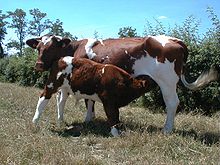|
Maine-Anjou
The Maine-Anjou is a French breed of domestic cattle, raised mainly in the Pays de la Loire region in north-western France. It was created in the nineteenth century in the historic province of Maine by cross-breeding the local Mancelle dairy cattle with Durham stock from Britain, and was at first called the Durham-Mancelle. In France it has been known since 2004 as the Rouge des Prés, but the Maine-Anjou name continues to be used elsewhere. It was formerly a dual-purpose animal, raised both for meat and for milk, but is now principally a beef breed. HistoryThe Maine-Anjou breed was created in the nineteenth century by owners of large estates in the traditional province of Maine, who cross-bred the local Mancelle dairy cattle with British Durham cattle – the breed that would later become the Shorthorn.[2]: 236 The resulting dual-purpose breed was thus originally known as the Durham-Mancelle. A herd-book was started in 1908, and the name of the breed was changed to Maine-Anjou. It was changed again in 2004, to Rouge des Prés, but outside France the older name continues to be used.[2]: 236 From about 1970, breeding favoured beef production over dairy use. The Maine-Anjou may display the genetic myostatin deficiency which produces "double muscling", but has not been selectively bred for this attribute.[2]: 236 The Maine-Anjou is reported from eight countries in the world, with an estimated total population of about 60000, of which approximately two thirds are in France.[4] Of these, some 90% are in the Pays de la Loire, and most of the remainder in the neighbouring Basse-Normandie and Poitou-Charentes regions.[2]: 236 About one third of the world population is in the United States, where registrations began in 1969.[2]: 236 UseThe Maine-Anjou was created as a dual-purpose breed, for both beef and milk. Since about 1970 it has been raised predominantly for beef. Maine-Anjou beef from Rouge des Prés cattle raised in the départements of the Deux-Sèvres, the Ille-et-Vilaine, the Loire-Atlantique, the Maine-et-Loire, the Mayenne, the Orne, the Sarthe and the Vendée received Appellation d'Origine Protégée status in 2010.[5] References
|
||||||||||||||||||||||||
